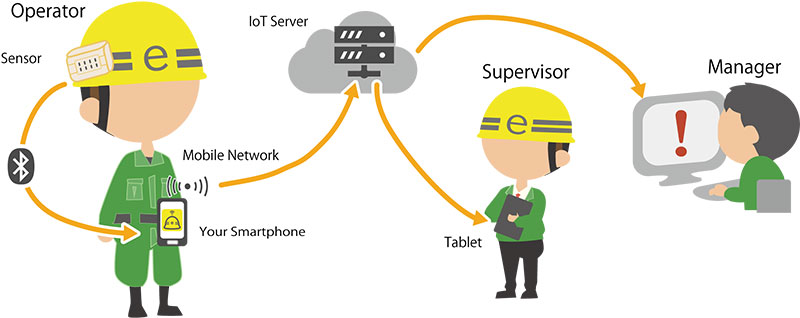Heat stroke prevention in hot work sites utilizing a wearable device
STARLITE CO., LTD.
| Publication date | November 28, 2022 (Posted on December 20, 2022) |
|---|---|
| Sector | Human Health, Industrial and economic activities |
Company Overview

STARLITE CO., LTD. is a company that provides solutions for social issues through monozukuri and original technologies with the mission to “realize an enriched life in harmony with nature.” Our three core businesses are: “Tribology” which supports the world’s key industries with tribology technologies, “Mobility Solutions” which develops new functions with consideration for reducing environmental burden, and “Safety & Life Support” which contributes to improving health and safety at work sites and disaster prevention.
Climate Change Impacts
Due to climate change, the number of extremely hot days is soaring every year, and so is the risk of heat stroke in the workplace. Despite growing awareness of heat stroke prevention and various measures being taken at workplaces in recent years, heat stroke fatalities in work sites remain unchanged. Furthermore, chronic understaffing in hot workplaces increases the workload per person, which inevitably leads to overwork, creating an environment prone to heat stroke.
Taking breaks at the right time is the most important measure against heat stroke, but it is difficult for supervisors and even workers themselves to know when to take breaks, which is a problem. As the heat is predicted to get even more severe, other measures are needed in addition to the current cooling methods.
Adaptation Initiatives
If heat stroke can be detected at an early stage, it is less severe, and recovery is possible. Based on this fact, we commercialized the heat stroke monitoring system “eMET,” which monitors individual workers by attaching a sensor to their helmets to detect any increased risk of heat stroke at an early stage and issue an alert (Figure 1).
An increase in deep body temperature is a major factor in heat stroke. The eMET monitors the condition of individual workers by checking their forehead temperature, which correlates with deep body temperature, in addition to measuring the heat index (WBGT) (Figure 2). The risk of heat stroke is visualized by sending the data collected via the wearer’s smartphone to a server in the cloud and quantifying it as a “body heat index” (Figure 3). If the risk of heat stroke increases, an alert is sent from the smartphone, notifying the wearer of the abnormality and also sending an email notification to the supervisor. This allows the wearer to take action to prevent heat stroke, such as taking a break.
In addition to visualizing the risk of heat stroke, analysis of data collected from eMET can be used to identify individuals, work sites and operations/tasks with a high risk of heat stroke, enabling individual care and workplace improvements.
Effects / Expected Benefits
Wearing an eMET can detect deteriorating conditions before subjective symptoms appear, and an alert is issued to protect workers from heat stroke. In addition, the data collected is also expected to help improve the workplace by comparing and analyzing the risk of heat stroke by season, location and job type, etc.
*Please note the eMET is not medical equipment.




